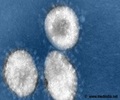A quicker and cheaper breed of electronic detectors for viruses like SARS and other biological materials have been developed by scientists at the University of Southern California.
Project leaders Zhongwu Chou and Mark Thompson point out that the basic nanotube and nanowire biosensors consist of a piece of synthetic antibody attached to a nanowire that's attached to an electrical base, immersed in liquid.If the protein to which the antibody binds is present in the liquid, it will bind to these antibodies, immediately creating a sharply measurable jump in current through the nanowire.
However, according to the researchers, their new design uses two new elements.
Firstly, it takes advantage of bioengineered synthetic antibodies-which are much smaller versions of the natural substances that are designed to bind with a specific protein and only that protein.
And secondly, it uses indium oxide (In2O3) nanowires instead of silicon and other materials previously tried.
The study has shown that unlike silicon, the metal oxides do not develop "an insulating native oxide layer that can reduce sensitivity."
Advertisement
It is also potentially considerably cheaper than alternatives.
Advertisement
The system could be useful in helping to establish certain important parameters for two-part biological systems like the antibody/target protein pair.
The protein the prototype system detects is the SARS (severe acute respiratory syndrome) virus n-protein, which infected more than 8,000 people in 2002-2003, killing nearly 10 percent of them.
The study has been published in ACSNano.
Source-ANI
RAS











